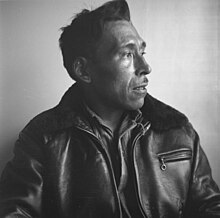Osuitok Ipeelee RCA (Inuktitut: ᐅᓱᐃᑐ ᐃᐱᓕ,[1] 23 September 1923 - 2005[2]) was an Inuk sculptor who lived in Cape Dorset, Nunavut. His sculptures in green soapstone of caribou and birds are particularly valued for their balance and delicacy. He was an early collaborator with James Archibald Houston, and by Houston's account was instrumental in the conception of the West Baffin Island Eskimo Cooperative. He was also one of the witnesses of the last-remembered traditional Inuit trial.[3]
Osuitok Ipeelee | |
|---|---|
| ᐅᓱᐃᑐ ᐃᐱᓕ | |
 | |
| Born | October 23, 1923 Neeouleeutalik Camp, Nunavut, Canada |
| Died | 2005 (aged 81–82) Cape Dorset, Nunavut, Canada |
| Known for | sculptor |
Biography
editYouth and early work
editIpeelee grew up in a traditional Inuit environment, learning to hunt and fish from his father, Ohotok Ipeelee, at a small camp near Cape Dorset. Ohotok also taught his son how to carve ivory, and as early as the age of thirteen Osuitok began to sculpt. This was encouraged by Roman Catholic missionaries, who bought carvings and commissioned small crucifixes from him. The artist's earliest extant works are ivory miniatures of hunting equipment, typical of the historic period of Inuit art, that date from the 1940s.
James Houston and subsequent career
editBefore Houston's 1951 expedition, Ipeelee was already regionally known as the greatest carver on Baffin Island. Under Houston's influence he began to carve sculptures in soapstone, which had a reliable market in the south. Exhibits of Inuit art at the National Gallery of Canada in 1952 and 1955 included his work, crediting him as "Oshaweetuk B". With recognition he began to receive official commissions. In 1955 he directed a team of craftsmen in the creation of the official mace for the Council of the Northwest Territories, and in 1959 he was asked to create a sculpture of Queen Elizabeth II, which was presented to the Queen upon her visit to Canada that year.
The birth of Inuit printmaking
editThe idea of a Cape Dorset printmaking program developed from a winter 1957 conversation between Houston and Ipeelee. As Houston recalled:
Osuitok Ipeelee sat near me one evening studying the sailor-head trademarks on a number of identical cigarette packages. He...stated that it must have been very tiresome...to sit painting every one of the small heads on the small packages with the exact sameness...
My explanation was far from successful...partly because I was starting to wonder whether this could have any practical application in Inuit terms.
Looking around to find some way to demonstrate printing, I saw an ivory walrus tusk that Osuitok had recently engraved...
Taking an old tin of writing ink... with my finger I dipped into the black residue and smoothed it over the tusk. I laid a piece of toilet paper on the inked surface and rubbed the top lightly, then quickly stripped the paper from the tusk. I saw that by mere good fortune, I had pulled a fairly good negative of Osuitok's incised design.
"We could do that," he said, with the instant decisiveness of a hunter. And so we did. [4]
Despite this, Ipeelee only contributed a total of four prints to the annual print collections, two in 1958 and two in 1959. He never returned to the medium explaining that he had not been paid enough for the drawings on which the prints were based, and found sculpture to be more profitable.
Works
editNotable sculptures
edit- Harpoon Head Figure (1983), serpentine. In the collection of the National Gallery of Canada.
Prints
edit- Musk Ox, 1958. Stonecut
- Weasel, 1958. Stonecut
- Four Musk Oxen, 1959. Stonecut and sealskin stencil
- Owl, Fox, and Hare Legend, 1959. Stonecut and sealskin stencil
Honors
edit- National Aboriginal Achievement Award, now the Indspire Awards, recipient, 2004.[5]
- Elected a member of the Royal Canadian Academy of Arts, 1973.[2]
Footnotes
edit- ^ "Artist: Osuitok Ipeelee, R.C.A. - ᐅᓱᐃᑐ ᐃᐱᓕ - E7-1154". KATILVIK. Retrieved 28 November 2023.
- ^ a b Osuitok Ipeelee at katilvik.com
- ^ Eber, Dorothy. (1997) Images of Justice: A Legal History of the Northwest Territories as Traced Through the Yellowknife Courthouse Collection of Inuit Sculpture. Ottawa: McGill-Queen's Press 1997. ISBN 0-7735-1675-1,On Google Books Archived 2016-09-09 at the Wayback Machine
- ^ James Archibald Houston, Fifty years of Thinking it Over, from Celebrating Inuit Art 1948–1970, ed. Maria von Finckenstein
- ^ "Biography at the Indspire website". Archived from the original on 9 October 2016. Retrieved 30 November 2019.
References
edit- Houston, Alma (1988). Inuit Art: an Anthology. Winnipeg: Watson & Dwyer. ISBN 978-0-920486-21-4.
- von Finckenstein, Maria; James Houston; et al. (1999). Celebrating Inuit Art 1948–1970. Toronto: Key Porter Books Limited. ISBN 1-55263-104-4.
External links
edit- Biographical entry at the Canadian Encyclopedia
- Image gallery from the National Gallery of Canada.
- Entry on the Union List of Artist Names